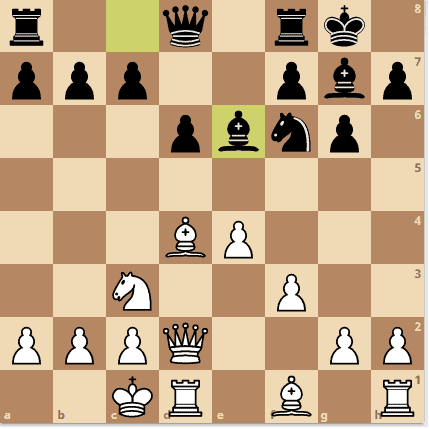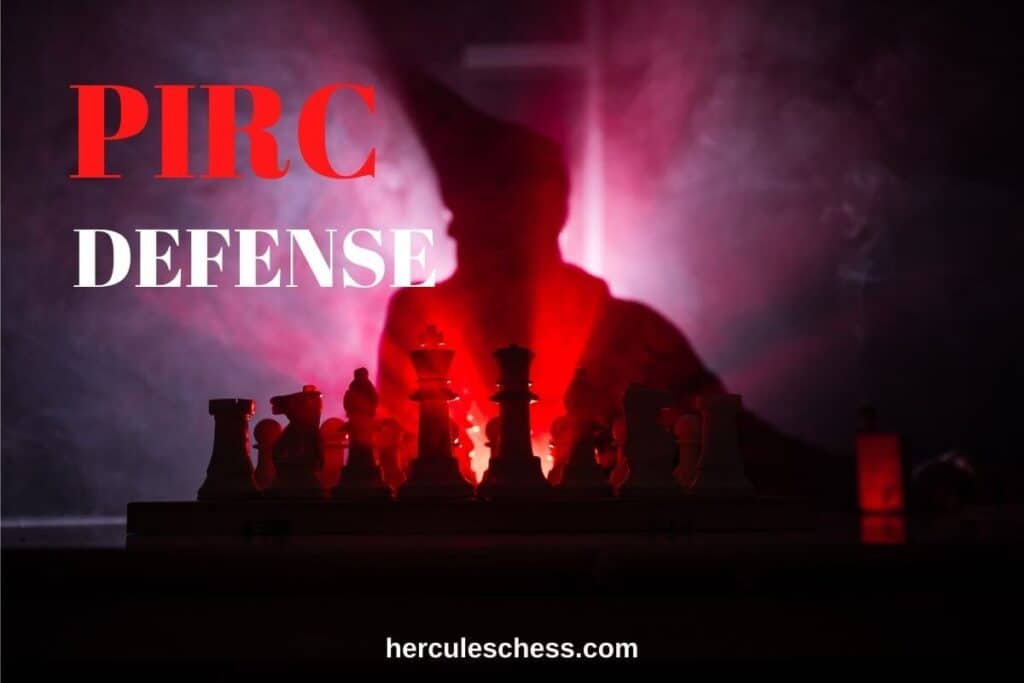This article features the Pirc Defense chess opening. The Pirc begins with the moves 1.e4 d6
With this modest looking move, Black is looking to develop his pieces as quickly as possible and keep the white center restrained. Only later will he plan a counterattack against the center.
Play usually continues 1.e4 d6 2.d4 Nf6 3.Nc3 g6

This defense is named after the Yugoslav Vasja Pirc, and is one of the “hypermodern” defense following that theory of controlling the center rather than occupying it.
White is allowed to create a pawn center that Black strives to undermine. The direct central confrontation is delayed, but the first moves anticipate this moment.
If Black has not planned his counterplay he can be overrunn, while if White pushes too far too fast he will be left with a shattered position.
Strategies In The Pirc Defense
Black is doing something a little audacious when he plays the move 1…d6
He’s allowing White an opportunity to occupy the center with the strong move 2.d4. Unlike the King’s pawn opening with 1.e4 e5, Black’s strategy here is to leave the center unchallenged for quite some time to come.
He’ll focus on developing his pieces quickly via Nf6, g6, Bg7, 0-0, restrain his opponent’s center and only later does he plan to use his piece pressure and pawn strikes to launch a counterattack in the center. This is done usually by playing c5 or e5.
White on the other hand is going to try to maintain his powerful center and at the same time he wants to complete his development and then systematically advance the center forward into the opponent’s position.
2…Nf6
After the move 2.d4 Black now plays 2…Nf6
Black’s first move in the Pirc (pawn to d6) is actually designed to prevent e4 to e5. It makes so that the knight on f6 is much more stable. If White tries to move 3.e5, Black would profit now from the fact that he can exchange on e5 and win material.
Black wins material if White pushes 3.e5

Clearly, the move 3.e5 is out of the question. Instead what White needs to play is 3.Nc3 simply defending the e4 pawn. Now Black plays 3…g6
With this move, he’s looking to develop the position to g7, complete his kingside development and train the bishop towards the center.
Black’s plan of playing g7, castle kingside and then chipping away at the center with the move to c5 or perhaps e5 is fairly straightforward.
White on the other hand has a few different strategies which he can choose from. One idea would be to advance pawn to f4. This is known as the Austrian Attack.
Austrian Attack of the Pirc

White is aiming to play e4 to e5 at some point and violently attack later in the game. Of course, the drawback of this strategy is that White is spending more time on pawn moves and this means that Black counterattack may be more successful if Black can deliver the blow in time.
Another strategy for White is simply the pawn development strategy 4.Nf3 and then simply Be2 followed by kingside castle. This is known as the classical setup for White. This is also another option for White
Classical Setup in the Pirc Defense

The 150 Attack
For the rest of this article, we shall check out a highly interesting system known as the 150 Attack, and that begins with the moves 1.e4 d6 2.d4 Nf6 3.Nc3 g6 4.Be3

With the move 4.Be3, White is signaling a number of important things. At the moment, White is making it more difficult for Black to achieve the move pawn to c5 since the Bishop is now bringing that square under observation.
Also, White is signaling that he plans to develop his queenside pieces, castle the king on the queenside and then to play for a pawn storm attack on the kingside.
In fact, this so called 150 Attack has now been widely recognized as one of White’s very best options against the Pirc opening.
Overtime, many master players handling the Black pieces have felt so intimidated by the attack White gets in this system that they’ve searched for methods to avoid castling kingside. Or even they’ve avoided fianchettoing the bishop.
For this reason, some players have begun playing with the move 4…c6. Then after 5.Qd2, Black simply plays pawn 5…b5 , threatening to oust the knight on c3 and attack the pawn on e4.
To cover the e4 pawn, White simply plays 6.Bd3 and Black replies with his own simple developing move 6…Nd7.

Black’s idea here is to get a little head start on attacking the queenside. This will make castling queenside somewhat less attractive for White.
Another benefit of this setup is that by avoiding Bg7, Black has avoided the standard exchanging maneuver, ‘Bh6’.
Of course, there are also some real drawbacks to Black’s strategy here as well. If White simply remains calm and play something like Nf3 followed by kingside castle, he does lose some capacity for an attack on the kingside, but he can reason that he has achieved a little lead in development.
He still maintains his center pawns, and perhaps Black’s pawns on the queenside will turn out to be weakened one day.
This plan of c6 and b5 is interesting, but ultimately White can still count on an advantage in these positions.
Let’s take a look at a more natural move, 4…Bg7 to find out how White still builds his attack there.

Now, white can simply go ahead with the move 5.Qd2 but often he likes to start with the move 5.f3 so that he never has to worry about Knight g4.
Another strong points about the move 5.f3 is that White is starting to support his kingside pawn storm. He is ready to start looking for g2-g4 and h2-h4. This is quite a strategical helpful move.
Once again, Black can delay kingside development by simply playing 5…c6
Ultimately after the move 6.Qd2 b5, White gets a pleasant game after either 7.g4 or simply castling queenside.

Now it may appear that Black has a little bit of head start on the queenside attack in this position, However, because Black has already played Bg7 in this position, Bh6 will be much stronger when White achieves it.
So instead after the move 5.f3, Black often prefers to castle kingside. In doing this, Black is simply sticking with his overall opening strategy of developing quickly and then striking against the center later.
Many games have eventually demonstrated however that White gets great attacking chances, but many players handling the Black pieces still aim for this traditional setup.
The idea is that after the Whites standard 7.Qd2, Black begins a counter strike in the center with 7…e5 8.Nge2 Nc6 putting pressure on the d4 point.

From this position, White has a couple of different ways of building his attack. For example, 9.d5 is a definite possibility. But the simplest approach is probably castle queenside (9.0-0-0), just leaving the tension alone in the center and completing development.
Now White is very primed to begin launching his attack with g2-g4 as soon as he gets the opportunity.
Attacking The Pirc Defense
To show an example of how Whites attack comes together, after the popular move 9…a6 preparing b5, White can continue with his stock move 10.g4 beginning the sharp attack on Black’s king. Black plays 10…b5 with the idea of playing b4 and bring the pawns forward in search of an attack on the queenside.
It’s now at this moment that White plays 11.d5!

No matter whether Black plays the 11…Ne7 or 11…Na5, White will continue with the move 12.Ng3 and he’s getting very close to the big attacking idea which is simply h4-h5 beginning to open lines and create a critical attacking condition for White.
At the same time, White also with his last move uncovered the bishop on f1 so that of the knight were to try to sink itself into c4, White would simply capture the knight and then get on with this ambitions on the kingside.
These positions are so dangerous for Black that we might even go so far as to say that he’s close to being objectively lost. It’s positions like these that have modern grandmasters so enthusiastic about White’s chances in the so called 15o Attack.
Tactics In The Pirc Defense
Realistically, after White has castled on the queenside, Black probably needs to try another strategy rather than that straightforward move 9…a6.
Therefore another popular attempt has been 9…dxe4 10.Nxd4 Nxd4 11.Bxe4 Be6

By bringing about some exchanges, Black has freed his position a bit and no longer has to worry about d4 to d5. However, White still has plenty of scope for a kingside attack, whereas Black is a long ways away from creating real threats against White’s king.
In positions where both sides castle on opposite sides of the board, attacking the king is the essential strategy and Black is probably going a little too slowly.
Play continues with the moves 12.g4 c5 13.Be3 Qa5
There are fascinating complications ahead. if white tries to take 14.Qxd6, he’ll find himself in big trouble after the outstanding move 14…Nxe4 which wins in all variations. 
Conclusion
Once again, keep in mind that grandmasters today often avoid these kinds of positions by either refusing to castle or even sometimes refusing to fianchetto the dark squared bishop.
As we’ve seen, Black is just a couple natural developing moves away from an incredible dangerous situation, and so many club players will fall into this situation.
Main strategies in the Pirc Defense
Here is a summary of the main strategic goals in the Pirc defense:
The usual counterplay for Black is to augment his fianchettoed king’s bishop with e5 or c5, pressuring the central dark squares. Usually this waits until after Bg7 and 0-0, but sometimes it is desirable to break more quickly.
White plans to develop his pieces and advance in the center if Black does not prevent it. The timing of a White central advance or Black counterthrust is critical.






